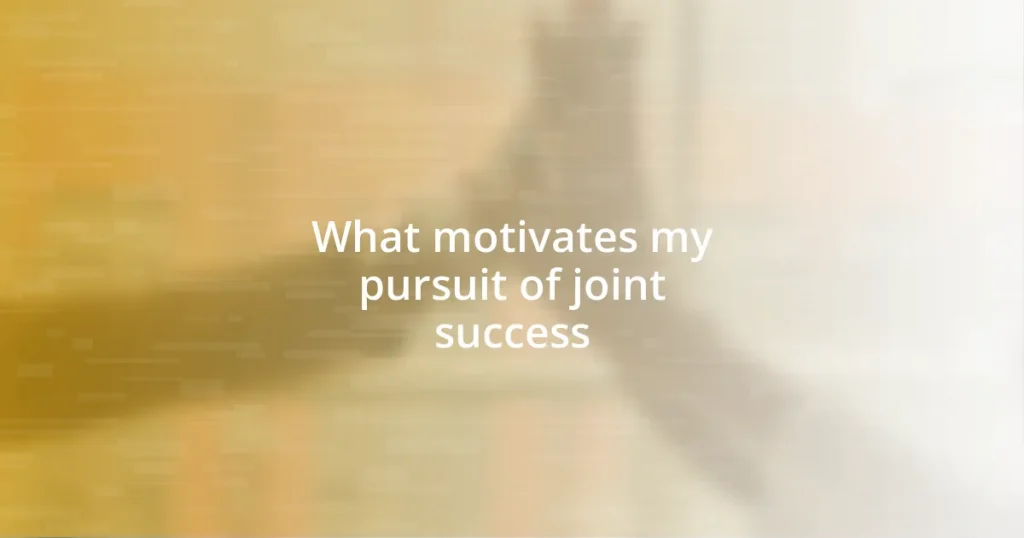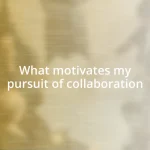Key takeaways:
- Personal motivations for success include a passion for lifelong learning, personal growth, and the desire to inspire and impact others.
- Strong partnerships are built on trust, shared vision, mutual benefit, flexibility, and celebrating successes.
- Effective communication strategies—such as active listening, clarity, and feedback utilization—enhance collaboration and foster stronger relationships.
- Measuring success involves both qualitative and quantitative metrics, reflecting on individual contributions, and maintaining ongoing dialogue about progress and challenges.
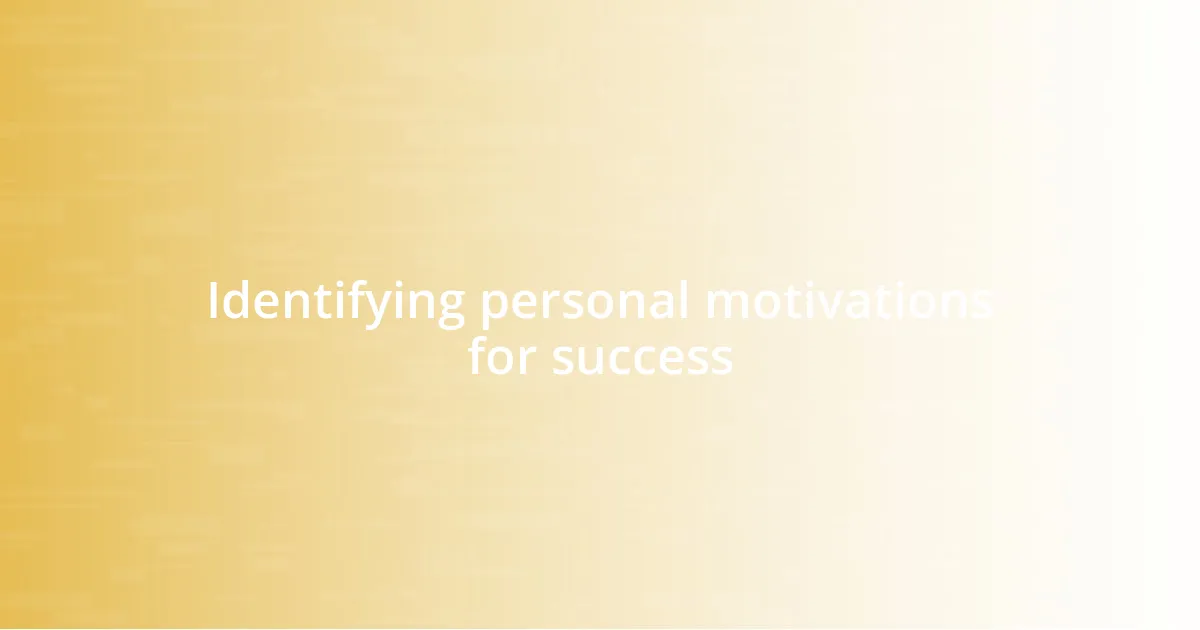
Identifying personal motivations for success
Identifying personal motivations for success often takes a deep dive into our values and aspirations. For me, the turning point came when I realized that my passion for lifelong learning was driving my pursuit of success. It was an eye-opening moment—what if my achievements could inspire others to embrace their own learning journeys?
When I reflect on what truly fuels my ambition, I discover a blend of personal growth and the desire to make a meaningful impact. There was a time when I volunteered for a local charity, and witnessing the positive change we created together ignited a fire within me. It made me question, how can my success contribute to others? This realization shifted my goals toward collaborative achievements, reinforcing that success is often sweeter when shared.
Another motivational aspect for me has been the connection to my family. I often picture them looking back on my journey with pride, and that vision propels me forward. It’s an emotional drive that intertwines personal achievements with collaborative success. So, what motivates you? Consider the moments in your life that stirred your heart—those might just reveal the core of your ambitions.

Building strong partnerships for growth
Building strong partnerships is essential for growth. I cannot stress enough how much I value the relationships cultivated along my journey. A standout moment for me was during a collaborative project with a local startup. We shared our resources and ideas, and the result was beyond what either of us could have achieved alone. That experience reinforced my belief that partnerships can amplify our efforts and lead to unexpected success.
Here are some key elements that contribute to building strong partnerships for growth:
- Trust: Establishing a foundation of trust ensures open communication and fosters a safe space for idea exchange.
- Shared Vision: Having aligned goals helps keep all parties motivated and focused on common outcomes.
- Mutual Benefit: Partnerships thrive when each party feels they are gaining something valuable from the collaboration.
- Flexibility: Adjusting strategies and approaches as needed shows a commitment to the partnership, accommodating each other’s needs.
- Celebrating Successes: Acknowledging accomplishments, no matter how small, cultivates a positive environment and fosters deeper connections.
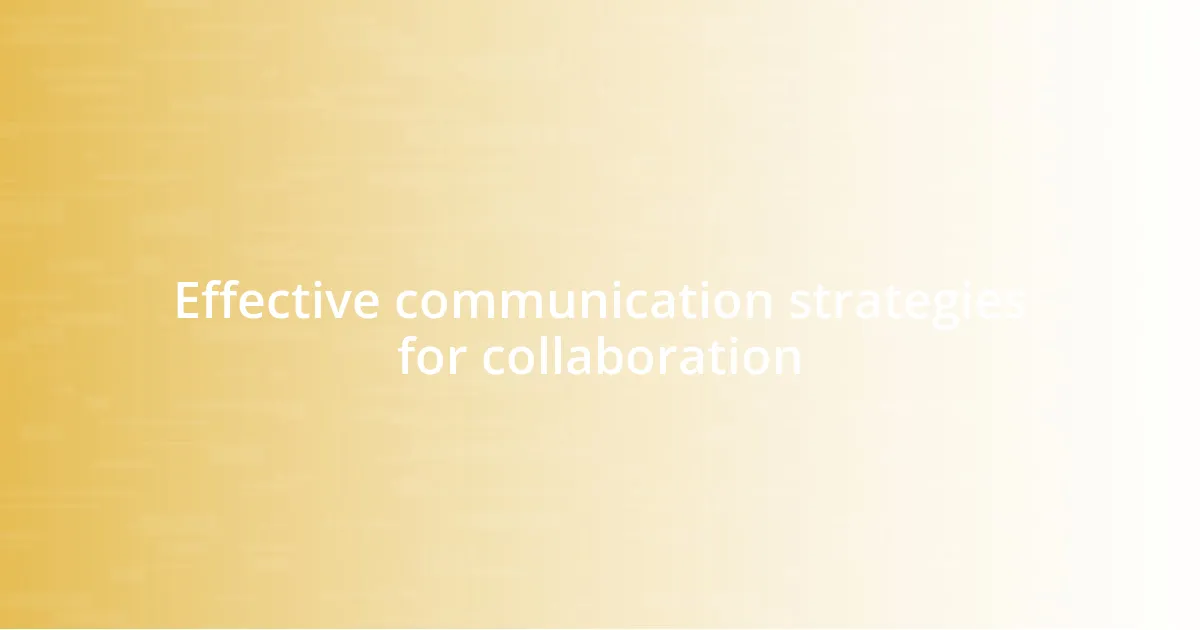
Effective communication strategies for collaboration
When it comes to collaboration, effective communication strategies are vital. I find that using active listening not only builds trust but also strengthens relationships. For instance, in a recent team meeting, paying close attention to a colleague’s perspective opened my eyes to alternative solutions we hadn’t considered. That moment taught me that listening can be just as powerful as speaking.
Clarity in communication is another essential strategy. I’ve noticed that when I articulate my thoughts clearly, it reduces misunderstandings and fosters collaboration. An example from my own experience is when I set up a shared document to outline our project goals. This simple action allowed everyone to visualize our objectives, which led to more productive discussions and a unified effort toward our shared success.
Finally, utilizing feedback effectively has had a profound impact on my collaborative projects. In one initiative, I encouraged team members to share their thoughts on our strategies openly. This approach not only made everyone feel valued but also resulted in innovative ideas that propelled our efforts forward. I believe that creating an environment where feedback thrives leads to stronger and more effective collaborations.
| Communication Strategy | Description |
|---|---|
| Active Listening | Engaging fully with others to understand their perspectives and foster trust. |
| Clarity | Clearly articulating ideas and goals to reduce misunderstandings and enhance focus. |
| Feedback Utilization | Encouraging open feedback to create a sense of value and inspire innovative solutions. |
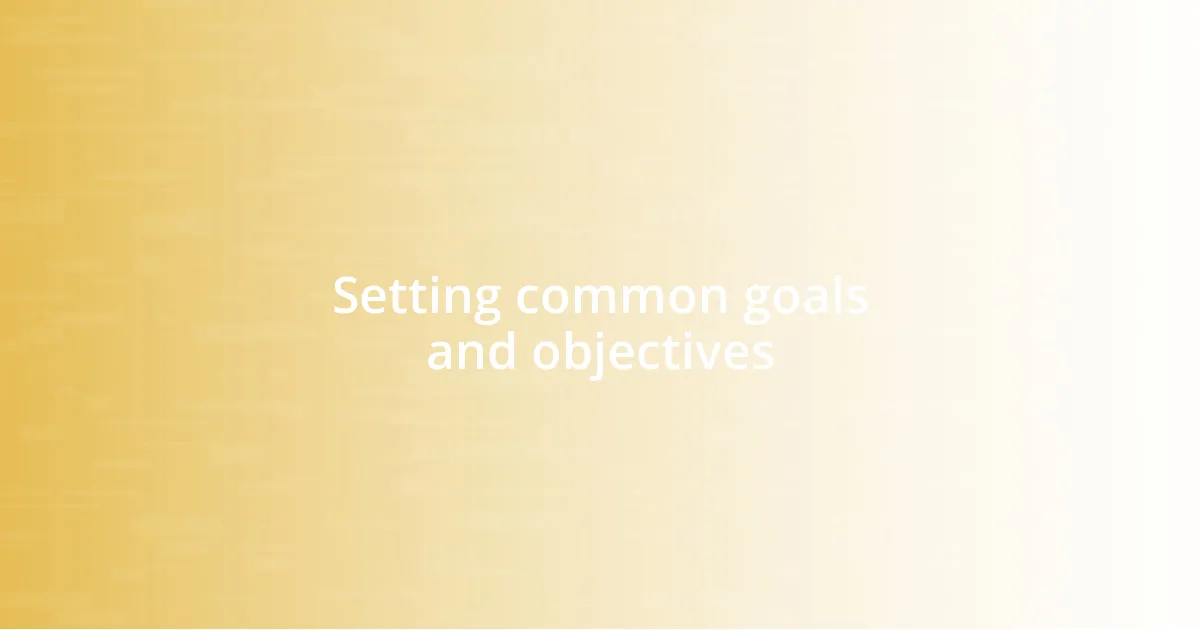
Setting common goals and objectives
Setting common goals and objectives is the cornerstone of any successful partnership. I remember a project where we brought together diverse talents from different departments, and our initial brainstorming session was eye-opening. It struck me how powerful it was when everyone shared their aspirations and aligned them into a set of collective goals. It created a sense of unity and purpose that fueled our collaboration.
One thing I’ve learned is that flexibility in these goals is just as crucial as having them in the first place. In one instance, we faced unexpected hurdles that necessitated a shift in our objectives. Instead of viewing it as a setback, we seized the opportunity to refine our goals, which ultimately led to a more innovative final product. Isn’t it interesting how sometimes, the path we didn’t plan can yield the most rewarding results?
Establishing these common goals isn’t just about laying down plans; it’s about weaving a shared narrative that everyone can connect to emotionally. I’ve noticed that when team members feel personally invested in these objectives, their motivation levels soar. It reminds me of a time when we celebrated hitting a key milestone together; the excitement in that moment was palpable. Celebrating those achievements reinforces bonds and reminds us that we are all in this together. How often do you take time to celebrate your collaborative successes?
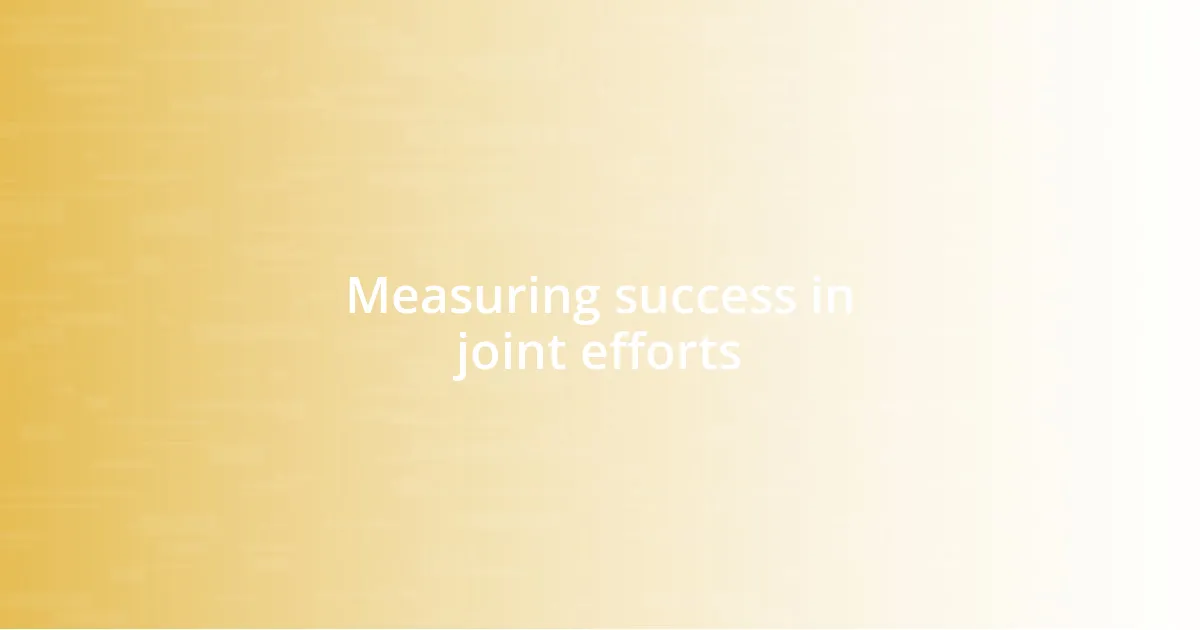
Measuring success in joint efforts
Measuring success in joint efforts can sometimes feel daunting because success can manifest in various ways. In my experience, I’ve found that both qualitative and quantitative metrics should be employed. For instance, I once worked on a project that combined numerical performance indicators with team sentiment surveys. The hard data showcased our progress, while the feedback highlighted team morale—both equally important in assessing our overall success.
Another approach I appreciate is reflecting on individual contributions within a group dynamic. I recall a project where different team members had distinct roles, and we evaluated success not only by final outcomes but also by how well everyone felt their strengths were utilized. The satisfaction I saw in my colleagues when their unique skills were acknowledged was incredibly motivating and reinforced a collective sense of achievement.
Lastly, I can’t stress enough the value of fostering an ongoing dialogue about success. I remember a debriefing session we held after completing a major initiative. Instead of a one-time review, it felt more like an open conversation about what worked well and what we could improve upon. Isn’t it fascinating how discussing our journey together not only measured our success but also built a stronger foundation for future collaborations? This reflective process allowed us to celebrate our victories and learn from our challenges, ultimately enhancing our joint efforts.
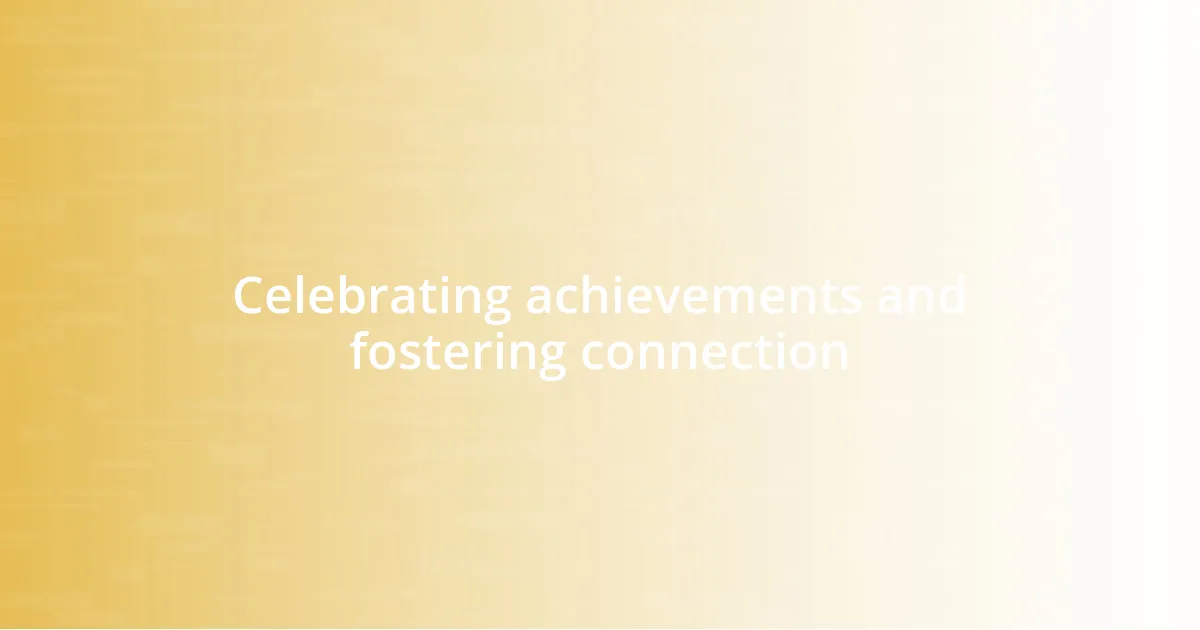
Celebrating achievements and fostering connection
Achieving a milestone in a joint effort is more than just ticking a box; it’s a moment to share joy and foster deeper connections. I recall when our team completed a significant phase of a long project, and we didn’t just crunch numbers or analyze results—we took the time to acknowledge each individual’s contribution. We gathered for an informal celebration, complete with snacks and stories, and I could feel the camaraderie growing. Have you ever noticed how such moments can transform a group into a community?
As we recognized our achievements, I observed something magical happening: barriers dissolved, and laughter filled the air. Those celebrations created an atmosphere where vulnerability was welcomed, sparking heartfelt discussions about our challenges and victories. I vividly remember a colleague sharing how they had struggled, and in that moment of openness, it became clear how much we’d all learned and grown together. Isn’t it empowering to foster such connections through sharing our journeys?
Building a culture of celebration has a ripple effect on our collective motivation. I’ve seen firsthand how acknowledging both big wins and small victories rejuvenates teams. During a quarterly review, we introduced a ‘shout-out’ segment, allowing everyone to highlight contributions that inspired them. The energy in the room shifted; enthusiasm and gratitude filled the space. How often do you take a moment to celebrate not just your achievements, but the journey you’ve traveled together?










